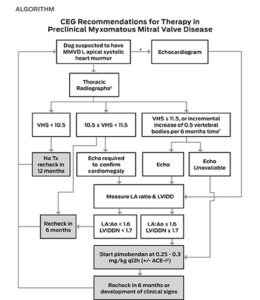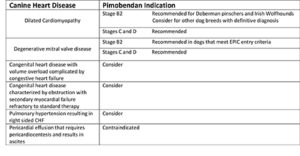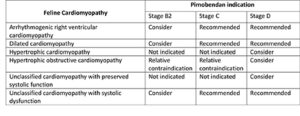Above: Dr. Saki Kadotani, clinical assistant professor, is shown here in the hospital’s new interventional radiology suite.
Pimobendan is a drug with both inotropic and vasodilatory properties that is used for the treatment of various cardiac diseases. As additional research is published, the indications and recommended uses of pimobendan continue to evolve.
How should you apply these findings in your clinical practice?
Use in Dogs
Preclinical Dilated Cardiomyopathy (DCM) (Stage B2)
This stage is characterized by systolic dysfunction and left ventricular dilation, with or without left atrial enlargement. Many dogs will also have concurrent supraventricular and ventricular arrhythmias. The primary diagnostic criterion for preclinical DCM is left ventricular systolic dysfunction and therefore echocardiography is required to establish a diagnosis. Studies in Doberman pinschers and Irish wolfhounds with preclinical DCM show that pimobendan is associated with delaying the onset of congestive heart failure and longer overall survival times.
Preclinical Degenerative Mitral Valve Disease (DMVD) (Stage B2)

DMVD is the most common heart disease in dogs, affecting middle-aged to older small breed dogs.
This stage is characterized by a loud left apical systolic heart murmur (> Grade 3). Dogs in stage B2 show radiographic and echocardiographic evidence of heart enlarge is recommended for dogs that have a confirmed diagnosis of preclinical DMVD and radiographic and echocardiographic heart size measurements that meet or exceed the following criteria extrapolated from the EPIC study and now part of the ACVIM staging consensus criteria:
- > Grade 3 out of 6 murmur
- Radiographic vertebral heart size (VHS > 10.5)
- Echocardiographic left atrium/aorta ratio (LA/Ao) ≥1.6
- Echocardiographic normalized left ventricular diastolic diameter indexed to body weight (LVIDDN) ≥ 1.7
If echocardiography is not available but the signalment and murmur characteristics support DMVD and the dog has radiographic evidence of cardiomegaly with a VHS ≥ 11.5, pimobendan can be considered. If the VHS is > 10.5 but < 11.5, echocardiography is strongly recommended to guide recommendations regarding pimobendan use (Figure 1).
Clinical Dilated Cardiomyopathy or Degenerative Mitral Valve Disease (stage C and D)
This stage includes past or current clinical signs of congestive heart failure secondary to DCM or DMVD. Pimobendan added to heart failure therapy improves clinical status, delays onset of refractory signs of heart failure and increases survival times.
Use in Cats
The efficacy of pimobendan in cats has not been reported. The predominant type of cardiomyopathy is hypertrophic (HCM) with preserved or normal ventricular systolic function and therefore the rationale for using a positive inotrope in cats with HCM is not entirely clear. A recent prospective study demonstrated that pimobendan does not improve survival times in cats in congestive heart failure secondary to HCM.
Cats with hypertrophic obstructive cardiomyopathy have HCM with evidence of left ventricular outflow tract obstruction. Because outflow tract obstruction is a relative contraindication for pimobendan, an echocardiogram is recommended before administering it to cats with congestive heart failure.
However, pimobendan should be considered in cases where systolic dysfunction is observed such as dilated cardiomyopathy, arrhythmogenic cardiomyopathy, and cardiomyopathy with systolic dysfunction or in cats with refractory/ end-stage CHF (stage D).
References
- Keene BW, Atkins CE, Bonagura JD, et al. ACVIM consensus guidelines for the diagnosis and treatment of myxomatous mitral valve disease in dogs. J Vet Intern Med. 2019;33(3):1127-1140. doi:10.1111/jvim.15488
- Summerfield NJ, Boswood A, O’Grady MR, et al. Efficacy of pimobendan in the prevention of congestive heart failure or sudden death in Doberman Pinschers with preclinical dilated cardiomyopathy (the PROTECT Study). J Vet Intern Med. 2012;26(6):1337-1349. doi:10.1111/j.1939-1676.2012.01026.x
- Schober KE, Rush JE, Luis Fuentes V, et al. Effects of pimobendan in cats with hypertrophic cardiomyopathy and recent congestive heart failure: Results of a prospective, double-blind, randomized, nonpivotal, exploratory field study. J Vet Intern Med. 2021;35(2):789- 800. doi:10.1111/jvim.16054
- The Cardiac Education Group (CEG): https://cardiaceducationgroup.org/resource/article-guides/
By Saki Kadotani, DVM, DACVIM (Cardiology)






